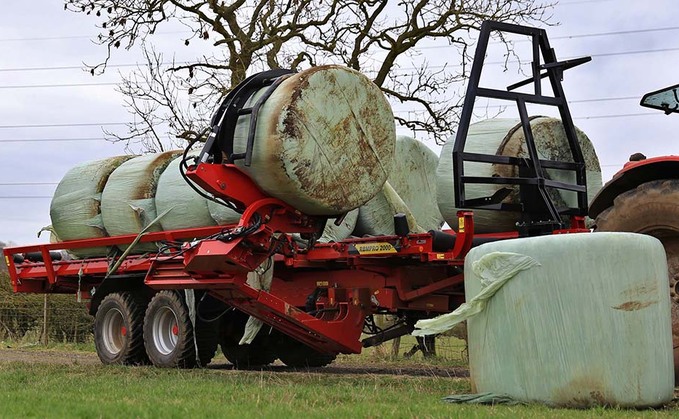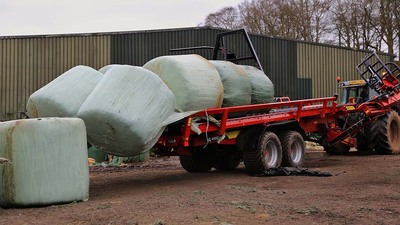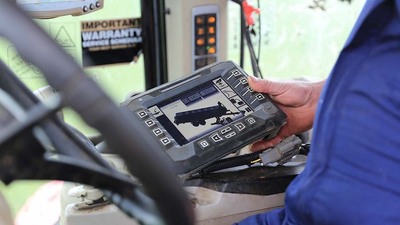
For one Scottish farmer, the logistics of collecting and hauling round bales has become a streamlined affair, thanks to a Canadian round bale chaser. Alex Heath finds out more.
Operating as a one-man band at times has its difficulties, non-more apparent than around silage season, with multiple operations to complete with time and weather often conspiring against you. For Lanarkshire based John Henderson this is particularly true and the reason he opted to explore the round bale chaser market, three years ago.
Mr Henderson says: "I cut, rake, bale and wrap all my silage in-house now, as I wanted more control over the quality of the silage. It affords me the flexibility to cut when the weather allows and the grass is at the right stage.
"Too often if you are busy or the contractor has other jobs to do, bales are left in the field for over a week, which does nothing for the quality of the silage.
"While there are plenty of ‘tube' bale chasers on the market, these were not much use to me for a number of reasons. The bales are lifted and lowered multiple times, which increases the chance of scuffing on the ground and breaking the seal of the wrap on the bars.
"In addition, the bale needs to be left on its round edge. I find bales store better when ‘bean canned' and left on the flat side when wrapped, this not only stops them slumping but also has much more wrap to protect from impact on the ground and crow damage. Even if super crow has managed to peck through 20 layers of wrap on the ends, chances are it will seal again in the stack as another bale is placed on top of it.
"So, when I saw the Anderson in a pre-LAMMA special in 2018, I was instantly interested and got a demo of it to see how it worked from importer D Clifford and Sons contractors, down in Nottinghamshire."
The bale chaser in question is the Canadian built Anderson RBMPRO2000. With a capacity in silage of 14 bales, Mr Henderson says 56 bales per hour can be shifted from field to yard, with most fields within a mile radius of the homestead. However, in straw the capacity is upped to 20 bales, with two rows of seven on the bottom layer and six bales across the top. The chaser is used extensively from May through to the last of the straw harvest in November.
He says: "It takes about seven minutes to gather a load on to the trailer, and just a couple of minutes to unload in the yard. The time on the road is the determining factor of productivity. However, to load 14 bales in that time with a loader and trailer, you would have to be some operator and it would require running up and down the field with the loader causing compaction."
Lifting the bales is an arm and grab that operates to the right of the machine.
"When you get in the field, everything is automatic," says Mr Henderson.
"You simply press the load button on the terminal, and the chaser goes through its sequence without any further input.
"The arm drops down and configurates itself to the orientation of the bale, that I have told it we are picking up. It can pick them sitting on the round side or flat side. Driving into the bale, a bar on the back is depressed, prompting the grab to squeeze the first bale and put it to the far side of the chaser. It then lowers itself, grabs the second bale and puts that on the near side. The headboard slides backwards, pushing the bales down the trailer and the process repeats. It counts the bales on to the bed and shows me how many are on-board. When 14 are loaded, the arm folds up and the grab sits around the last bale, ready for the road."
Mr Henderson says he typically drives at 10kph between bales, slowing to 3-4kph when lining up a bale. While bales placed on their flat ends are easy to grab and can be got from any direction, those on the round side are significantly more difficult to work with, he comments, reinforcing his bean can preference.
"It is a really neat package and as compact as any other 28-foot bale trailer, behaving well enough on the road, while 550/45-22.5 tyres leave little imprint in the field. My Massey Ferguson 6718S handles it well.
"In the yard, I select unloading mode on the screen. There are two ways the bales can be placed in the yard, either on the round side or on the flat end. I pull a spool lever and the bed of the chaser and the drawbar pivot, lowering the rear. If they need to go on the rounds, the rear touches the floor and runs on a skid.
"I like them stacked like bean cans, so only lower the rear by a small amount. Again, the arm unfolds and the headboard pushes the bales off as the tractor creeps forward. It takes a bit of practice to get the speed right, ensuring there is enough space for the stack loader to get between the bales, but you pick that up quickly enough."
Compared to Mr Henderson's previous method of bale collection, using front and rear twin-bale carriers, shifting four bales at a time, this method has revolutionised his operation, he says.
Single-handedly, Mr Henderson makes and shifts about 3,000 bales per year of silage and straw, so the investment which was in the region of £40,000 when he bought it is well justified, he says.
"If I were to get contractors in to lift the bales, loaders and trailers would be all over the fields, causing a mess as invariably bale carting is a job for wet days. Coupled to that, I would be paying about £3 per bale if a loader and two tractor-trailer outfits were on the haul, which is what is needed to keep up with the chaser, which soon mounts up.
"I looked at getting a bale trailer, but you looking well over £10,000 for a decent spec 28-foot, then I would need another loader or put one on the front of the tractor, another £10,000 and still have a lot of downtime uncoupling and running back and forth to the trailer, so the chaser is a no-brainer to me."
Despite its complex loading arm, the chaser has had little in the way issues and structurally, the machine is standing up well to the topography of the local area, however, some reinforcing has had to be done.
"I am not sure foreign manufacturers appreciate the weights in UK and Irish silage bales. My 4ft bales are typically 800kg, which is a lot for a machine to put up with, especially as when they are loaded, they drop about 300mm.
"When it first came, a couple of rollers that form the bed popped out and you could see the sides retaining them bowing with a full load on. In fairness to Cliffords, they were straight onto the issue and came up with a reinforcing solution, whereby every couple of foot, a piece of threaded bar and tube spacer were put in between the rollers, holding everything in," he adds.
Overall, Mr Henderson has found the bale chaser to be a valuable addition to the farm.
"It speeds the job up no end and is a true one-man operation. I am sold on the concept and it will not be leaving my farm for a long time as it saves me time, money and hassle," he concludes.



Verdict
Compared to Mr Henderson's previous method of bale collection, using front and rear twin-bale carriers, shifting four bales at a time, this method has revolutionised his operation, he says.
"It speeds the job up no end and is a true one-man operation. I am sold on the concept and it will not be leaving my farm for a long time as it saves me time, money and hassle," he says. "It is simple to use and has been reliable to date. It is the only machine on the market that can pick the bales up in bean can position and put them back down on their flat edge, which is important to me."



























